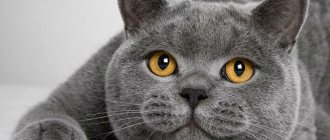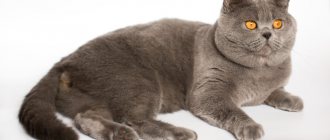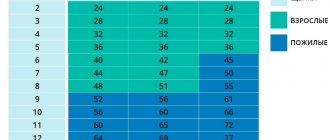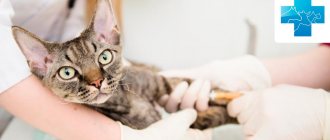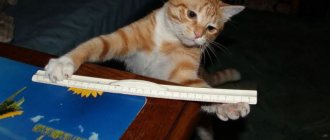How to determine the age of a cat by human standards: table of the ages of cats and humans
There are quite a few tables and they all, although not very much, differ due to the fact that the researchers observed individuals of different breeds.
Table 2. Comparative table of age correspondence from birth to one year.
Table 3. Comparative table of age correspondence from 1 year.
Breed and favorable living conditions are the main secrets of long-livers
Stages of a cat's maturation compared to human years:
From 0 to 6 months
The period when a kitten grows very quickly and actively develops corresponds to human years of 0-7.5 years.
From 7 months to 2 years
During this period, the kitten matures and turns into an adult cat; by the age of 2, cats master all the wisdom of life and become fully grown animals. Corresponds to 8-25 years of human life.
From 3 to 6 years
The most active period of a cat's life: she is physically and behaviorally mature, healthy and alert. Corresponds to 25-45 human years.
From 7 to 10 years
A mature, self-confident animal, with proper care and quality nutrition, the cat leads an active life. Approximately 45-55 human years.
From 11 to 15 years
During this period, the animal becomes calmer, sleeps more, and plays less. The first signs of aging may appear: deterioration of vision, quality of coat and teeth. Accordingly, 60-75 human years.
From 16 years and over
An elderly cat, such animals need more careful care, vitamins and high-quality nutrition, in which case the pet will be around for many years to come. In human equivalent, over 79 years.
Of course, the calculations given in the article are approximate, but you can still estimate the age of your pet in human years.
Below is a table that can be used to approximately calculate the age of a cat by human standards.
How old are your cats? Share your stories in the comments.
Source
How many years do cats and cats live, and should they live?
Life expectancy is influenced by living conditions and breed.
- Wild cats live 5-7 years. Their life span is shortened due to injuries, infections, diseases, parasites, irregular, poor-quality nutrition, and active sex life. In cats, the vitality is undermined by frequent childbirth and feeding of offspring. Cats get it when they try to conquer a female and territory.
- Domestic cats live on average 8-15 years, but can live up to 25 years.
- Pedigree cats that were bred relatively recently and have an unusual appearance are unlikely to live long. This is due to the fact that a limited number of animals are used for breeding such breeds. Because of this, their ability to survive and immunity is lower. On average they live 10-12 years.
- Breeds that were bred a long time ago and developed in natural conditions can live quite a long time: British breeds - 15 years, Persian - 20 years, Siamese - 30 years.
- Males live on average two years less than females. The life of cats is shortened by the need to fight for territory and a female. This indicator does not apply to castrated cats.
Cat teeth
Life stages of cats
Childhood
Childhood is the most important stage in a pet's life. This period begins with the birth of the kitten and lasts for the first 6 months. At this time, the kitten is growing rapidly and adapting to the world around it. The baby develops immunity and character. By human standards, this is the age from birth to 6-8 years.
Youth
At the age of 6 months, the kitten looks much more like an adult animal, but still remains a child. At this age, he is actively developing, begins to learn to hunt and tries to interact with his brothers not only at the level of play, but also learns to defend his position.
At the age of 8-10 months, puberty occurs. It proceeds approximately the same as in adolescents. The hormonal system works as in an adult organism, which causes estrus in cats, and stimulates cats to mark their territory. At this time, it is still too early to have offspring; the genital organs continue to develop until physiological maturity, at the age of 10–16 months. In humans, this period begins at 7-8 years and lasts until 18-20 years.
Youth
Cats that have reached physiological maturity are considered young. This is the age from 2-3 years to 5 years. During this period, pets are not yet very experienced, but they are active and inquisitive, full of energy and strength. Youth corresponds to 20-35 human years.
Maturity
From the age of 6, cats enter a state of maturity, which lasts until 9-10 years. At our age this corresponds to 55-60 years. Pets of this age group are smart and calmer in nature than the younger generation. If in adolescence and youth a pet can be taught new behavior, then by maturity the skills and reflexes are firmly fixed in the animal’s mind.
Old age
Unfortunately, old age does not bypass cats. From 9-11 years of age, the body’s functioning gradually deteriorates, internal diseases and orthopedic problems appear, and the metabolic rate decreases. In science, this period is called geriatric.
Most cats live to be 13-16 years old, but there are centenarians who live 200 years or more! By human standards, aging of the body begins at 55-60 years and lasts up to 75-100 years.
Source
How to determine the biological age of a cat?
The main method of determining age is by the condition of the teeth, since a cat’s teeth change, grow, and fall out at a certain time. But this method is not absolutely reliable, since in an adult, teeth can deteriorate and fall out due to various negative circumstances and diseases.
Table 4. Changes in teeth depending on age
| Age | Dental condition |
| 3-4 weeks | baby teeth erupting |
| 4-5 months | in the same order that they erupted, baby teeth fall out and permanent teeth grow |
| 6 months | teeth change completes |
| 1 year | The central incisors located on the lower jaw are gradually ground down |
| 2 years | The middle incisors (premolars) located on the lower jaw are gradually worn away, yellowing of the teeth is barely noticeable |
| 3 years | The central incisors located on the upper jaw are ground down |
| 4 years | The middle incisors (premolars) located on the lower jaw are also ground down |
| 5 years | The fangs begin to wear down, the yellowing of the teeth is already clearly noticeable |
| 5.5 years | The extreme incisors (molars) located on the lower jaw are subject to wear |
| 6 years | The outer incisors (molars) located on the upper jaw begin to wear off |
| 7 years | the central incisors located on the lower jaw acquire a transverse oval shape |
| 8 years | The lateral incisors located on the lower jaw acquire a transverse oval shape |
| 9 years | the central incisors located on the upper jaw acquire a transverse oval shape |
| 10 years | The lateral incisors located on the upper jaw acquire a transverse oval shape |
| 11-12 years old | The central incisors on both jaws gradually fall out |
| 12-16 years old | all incisors are subject to loss |
| 16-20 | the last teeth fall out - fangs |
Teeth grow up to a year, but immediately after a year a gradual regression occurs: the teeth wear out, turn yellow, and fall out. It is these signs that veterinarians look at when determining the age of a cat. In this case, the bite and the general condition of the oral cavity are taken into account, since teeth can deteriorate prematurely.
Swedish cat Missan, contender for the title of oldest living cat in 2015
Eyes
The eyes of young individuals are clear with a characteristic curious shine. The iris is distinguished by its brightness and richness of colors, and the pattern is clear. As a cat ages, its eyes become dull, the lens becomes cloudy, the iris loses its brightness, and the pattern is disrupted.
Appearance
Juveniles have shiny, beautiful fur. With age, the coat thins, becomes dull, and gray hair appears.
Physical state:
- Teenage cats are somewhat lanky and clumsy.
- Young cats have prominent muscles.
- An adult, mature animal has a rounded shape. His movements, when at rest, become slow and lazy.
- In older cats, the bones of the shoulder girdle begin to protrude, thinness appears, and the skin gradually loses its elasticity and becomes flabby.
Long-lived Cream Puff, 38 years old
Animal and Human Age Converter
- home
- Calculators
- Life
- Time and date calculators
- Animal and Human Age Converter
No mammal can match the longevity of humans. And yet we make four-legged friends for ourselves, knowing that their life is short-lived. Who lives how long? When does he grow up and get old?
Using this online converter, you can easily calculate the number of years of the selected animal.
Online comparison of the age of a person or animal relative to other animals. To compare, just enter the age of someone and select a pair to compare, then click the “Calculate” button. This way you can find out the age of the corresponding animal.
To establish proper relationships between humans and animals, sometimes knowledge of age appropriateness comes to the rescue. Thus, according to the French magazine Le Dobermann, there are the following correspondences between the ages of dogs and humans.
| Dog age | Person's age | Compliance factor |
| 2 months | 14 months | 7.0 |
| 6 months | 5 years | 10.0 |
| 8 months | 9 years | 12.5 |
| 12 months | 14 years | 14.0 |
| 18 months | 20 years | 13.3 |
| 2 years | 24 years | 12.0 |
| 3 years | 30 years | 10.0 |
| 4 years | 36 years | 9.0 |
| 5 years | 40 years | 8.0 |
| 6 years | 42 years | 7.0 |
The American Home Guide for Cat Owners provides a table comparing the ages of cats and humans.
| Age of the cat | Person's age |
| 1 year | 15 years |
| 2 years | 24 years |
| 3 years | 28 years |
| 4 years | 32 years |
| 5 years | 36 years |
| 6 years | 40 years |
| 7 years | 44 years old |
| 8 years | 48 years old |
| 9 years | 52 years old |
| 10 years | 56 years old |
| 11 years | 60 years |
| 12 years | 64 years old |
| 13 years | 68 years old |
| 14 years | 72 years old |
| 15 years | 76 years old |
| 16 years | 80 years old |
Time and date calculatorsCalculator Calculation Converter Convert Time
Are you interested in top gadgets and popular technological innovations?
